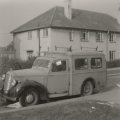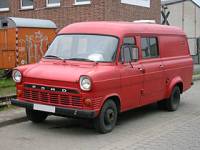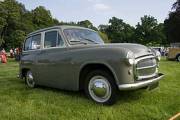Prev. Page: The (Market) Traders
Coleman Family History
The Colemans on Wheels
Other people have cars, the Coleman Family (in my memories) has always had vans !Why vans, why not cars, "like other folks" ?
I suppose the simple answer is, that My Dad was always a "trader". His Father and Grandfather sold stuff on the markets, and he did too. Even when he wasn't working the markets, and had a steady job, he would generally do a bit of trading on the side. This meant going to the wholesalers to buy "stuff" and then bringing it home, to sell it. Hence the vans !.
They were already second hand (meaning anything from fifth-hand to tenth-hand) when we bought them, and we usually overloaded them to make the maximum profit. We never had enough money to maintain them properly, so we had a lot of experiences with these vans, that the "normal" car owner couldn't have dreamt of.
(I say "we" because as soon as we were old enough to help out - we did !
It was always a "family business")
Some of these vans became "legendary" within the family. This section will tell some of these stories.

The Old Grey Mare was a Ford 10 cwt. van from the 1950's (officially, a Ford E83W(1)). It was already old when we bought it, hence the name. It had a cloth roof, and linoleum flooring in the back. We kids used to sit on boxes in the back, and I remember that the roof leaked in heavy rain, so we would be constantly moving around, trying to find a dry spot.
The engine was very weak, and one day we needed to drive up a big hill on the Exeter by-pass. The van could manage the first half of the hill, but in those days the reverse gear was the most powerful gear of all, so My Dad turned the van round and did the rest in reverse.
(1) For any one interested in old cars and vans,
you can find out more about the Ford E83W range here: Ford E83W
Lea Francis
 Always on the lookout for a bargain, My Dad bought a Lanchester coffin van. Not a hearse,
just a Lanchester estate car with a custom bodywork that had been fitted up to carry coffins.
Always on the lookout for a bargain, My Dad bought a Lanchester coffin van. Not a hearse,
just a Lanchester estate car with a custom bodywork that had been fitted up to carry coffins.My main memory of this is, is that it had a long lever for opening the driver's window, instead of the usual winding handle. Very fast, very simple, very effective - it was the only time I ever saw this.
The photograph is of a similar model, from the Wikipedia-Site, (courtesy of the owner).
In the early sixties My Dad stopped working for others and went back on the markets
 For a while he used the successor to the "Old Grey Mare", another Ford 10 cwt, known as "My Mum's Car"
but he really needed something bigger.
For a while he used the successor to the "Old Grey Mare", another Ford 10 cwt, known as "My Mum's Car"
but he really needed something bigger.
Through a friend and business contact, known as "Taff the Foam" (because he was a welshman and sold foam rubber), he bought an Austin LD 25 cwt. This was the first of a long line of Austin and Morris LD 25 and 30 cwt vans in various shapes and sizes, culminating in "Colemans of Cilfynydd"; the only van we ever had with our name painted on.
See an example here
Morris LD 25 cwt. (Dexion roof rack
As business improved, we needed a smaller van too, so we bought an Austin J2
 This van lasted us for many years, being patched up as we went along. The J2 is a forward control
van, which meant that the engine was between the driver and the passenger, and the carburettor
was under the passenger seat.
This van lasted us for many years, being patched up as we went along. The J2 is a forward control
van, which meant that the engine was between the driver and the passenger, and the carburettor
was under the passenger seat. Which was handy one day, when the mechanical 'bits' between the accelerator pedal and the carburettor snapped. I removed my passenger seat and perched on the edge of the frame, holding a piece of of string, which was attached to the carburettor. My Dad sat in the driver's seat and steered, changed gears etc, and I worked the accelerator with my piece of string. Well, at least it got us to the garage, where they could do a proper mending job !
The hand-brake was never any good and there were a lot of steep hills in Wales !
Fortunately the accelerator pedal was close enough that I could work it with my right hand, while my right foot was pressing the brake pedal.
For a while the J2 was joined by a newer modell, the Austin J4.
Nothing very memorable about this one, it was "just a van".
Seddon is a well-known name in the commercial vehicle world - mainly for lorries, 20 tons and more !!
But for a time, they also had a range of smaller vehicles, and we owned one of them.
Ours was a 25 cwt van with a Perkins P3 3 cylinder diesel engine. Seddon ceased production of this model in 1955 so ours must have been well over 10 years old. The steering was "not quite right", the van swayed from side to side a lot, but it "went like the clappers", one of fastest vans we ever had. It used to shake a lot too, and the gears were "heavy" to change: move the gear lever to roughly the right position and then thump it in !.
More memories: the radiator had a slight leak, so we couldn't use anti-freeze. In winter we had to drain it every night and fill it up in the morning, before we could drive anywhere - and we usually set off about 6 in the morning !
No photo (unfortunately) but you can see a 'Post Office' example here:
http://www.britishtelephones.com/vehicles/boxvehicles/014.htm
Morris FG404
No photo, but some photos here. Just imagine a blue cab and a large box-like goods container behind, and that's it. Just under 3 tons, and with a governor on the engine, so we could never drive over 50 mph (even though the motorway limit for vans was 60 mph !)
Commer BF van.

Not ours!
Just imagine this van in yellow (somewhat paler than canary yellow)
and then you know what our van looked like. .
 The Ford Transit was introduced in 1965. A few years later second-hand
Transit began to be within our price range, and most of our later vans were either
short-wheelbased or long-wheelbased Transit versions. After driving some of the vans
mentioned above, this was almost like driving a car. Taking advantage of the road-tax
laws for commercial vehicles, Later vans were always short-wheelbased and had to be
under 30cwt.
The Ford Transit was introduced in 1965. A few years later second-hand
Transit began to be within our price range, and most of our later vans were either
short-wheelbased or long-wheelbased Transit versions. After driving some of the vans
mentioned above, this was almost like driving a car. Taking advantage of the road-tax
laws for commercial vehicles, Later vans were always short-wheelbased and had to be
under 30cwt. The van in the photo was not one of ours, but is just a reminder of how they looked.

Another "My Mum's Car", although we all used it. The Hillman Husky was the nearest thing we had to a car, i.e. for driving around privately. The problem was, it couldn't "earn it's keep" i.e it was too small for "useful" purposes, and therefore too expensive, and we were used to using the vans as if they were cars, anyway, so the Husky didn't last long.
Again, not one of ours; just a reminder of how they looked.
Next Page: Coleman Cousins